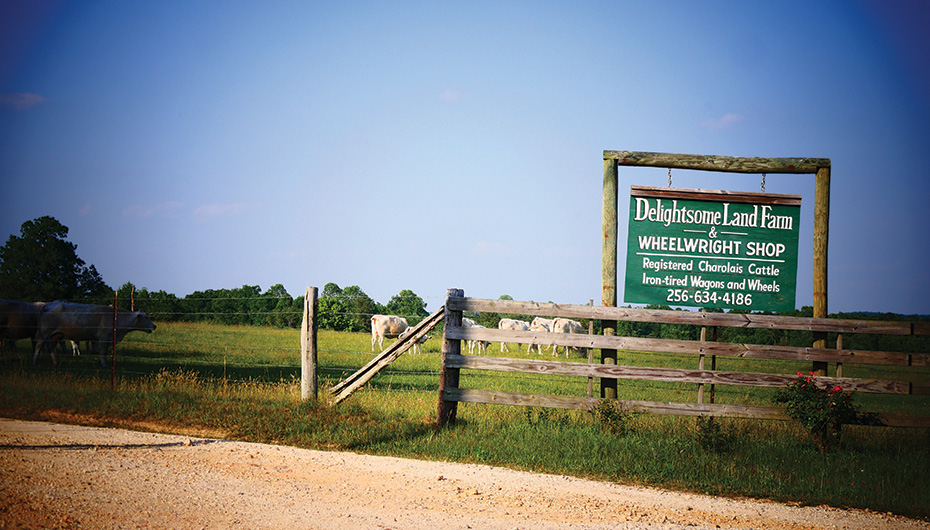Featured image: Hoyle Smith of Mentone builds and restores antique wagons
By Tyler Pruett
MENTONE, Ala.— For nearly 50 years, Hoyle Smith, 72 and his wife Joyce have called Mentone home. While born and raised there, Smith had moved to Atlanta to work on an automotive assembly line. After the birth of their first child, Hoyle and Joyce wanted to raise their children in a better place, so they moved home. While his daily job was delivering the mail, Mr. Smith developed a fascination with traditional woodworking and horse-drawn wagons.

Smith had experience with woodworking and carpentry, but had to start from scratch when it came to wagon-working. It all started 35 years ago, when his neighbor approached him with the remains of an antique wagon to rebuild.
“It had completely rotted down and left only the metal parts,” Smith said. “While I had never worked on wagons, I was born in 1944 and we didn’t even have electricity until several years later, and a lot of folks still used a wagon and mules to get around, so I had an interest in them.”
After Smith finished the woodwork on the old wagon, he parked it in front of the door of his house so he could use the porch light to work at night after finishing his duties as a mail carrier. He was left with only the wheels to complete.
“I didn’t know how to go about rebuilding the wheels, and I had heard of an Amish man in Ethridge, Tennessee who could do the work,” he said.
Smith waited a full year after dropping off the remains of the old wheels in Tennessee before making another trip to check on the status of the repair. The Amish craftsman checked his list of work to complete and informed Smith that he had made it halfway up the list, and his work should be done in another year.
“I told him that I couldn’t wait another year, and that the rest of the wagon had been blocking my front door,” Smith said. “Then he (the Amish wheelwright) told me, ‘well, it seems like you’re the kind that could build them yourself.’”
He pointed Smith in the direction of a book that explained everything and a catalog of traditional hand tools used for to reproduce wagon wheels. After a little practice, the Amish man was correct in his assertion that Smith was the type that could build them himself. He turned his passion into a trade.
“I’ve built hundreds and hundreds of wheels over the years,” Smith said. “I’ve restored many antique wagons and built many from the ground up.”
“A lot of people say that I have a gift to do this… Well, I disagree. If your heart’s in it, you can learn to do anything. People will say, ‘I wish I was able to learn to do this,’ but if your heart’s in it, you can,” Smith said.
 Smith has several antique wagons in his personal collection. For younger generations, it can be strange to think about common brand names normally associated with cars and engine-powered farm implements producing wooden, horse-drawn wagons. While many are familiar with antique machines bearing the Studebaker and New Idea name, it is not common knowledge that for decades these companies simultaneously produced wooden wagons. Mr. Smith owns one of each, and proudly displays a photo of a John Deere wagon he restored for a customer.
Smith has several antique wagons in his personal collection. For younger generations, it can be strange to think about common brand names normally associated with cars and engine-powered farm implements producing wooden, horse-drawn wagons. While many are familiar with antique machines bearing the Studebaker and New Idea name, it is not common knowledge that for decades these companies simultaneously produced wooden wagons. Mr. Smith owns one of each, and proudly displays a photo of a John Deere wagon he restored for a customer.
Walking in to Smith’s workshop is like stepping back in time. There are very few modern tools. Much of his equipment he had even built himself with the sole purpose of creating authentic wagon wheels. Over 50 wheels of various sizes were stacked along the walls; waiting to be fitted with the iron bands for future projects.
Although the idea of a horse-drawn wagon seems simple, much goes into the engineering. The correct wood has to be used, and things have to be just right in order to distribute the weight properly.
“If the spokes are not angled just right, the wagon will put all the weight on the spokes instead of the wheel; breaking them,” Smith explained.
In this online age, we can find hundreds of videos and step-by-steps to learn any skill our heart desires. Daily consumers are bombarded by do-it-yourselfs on social media. It is easy to forget that not that long ago, learning a forgotten skill meant serious dedication and ingenuity without all of the required information at your fingertips. Hoyle Smith is a reminder of not only a lost trade, but of the hard work and creativity that makes Mentone such a unique and great place.





